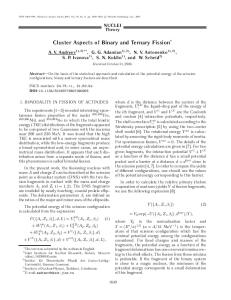Experiment aimed at the study of 252 Cf binary and ternary fission
- PDF / 600,643 Bytes
- 4 Pages / 612 x 792 pts (letter) Page_size
- 70 Downloads / 299 Views
Proceedings of the National Conference on Nuclear Physics “FRONTIERS IN THE PHYSICS OF NUCLEUS” St. Petersburg State University, Russia June 28–July 1, 2005 Experimental Investigations of Nuclear Reactions
Experiment Aimed at the Study of
252
Cf Binary and Ternary Fission*
A. V. Daniel1)** , J. H. Hamilton2) , A. V. Ramayya2), A. S. Fomichev1), Yu. Ts. Oganessian1) , G. S. Popeko1) , A. M. Rodin1) , G. M. Ter-Akopian1), J. K. Hwang2) , D. Fong2) , C. Goodin2) , K. Li2) , J. O. Rasmussen3) , D. Seweryniak4) , M. Carpenter4) , C. J. Lister4), Sh. Zhu4) , R. V. F. Janssens4) , J. Batchelder5), J. Kliman6) , L. Krupa6), W.-C. Ma7) , S. J. Zhu8) , L. Chaturvedi9), and J. D. Cole10) Received October 31, 2005
Abstract—A new experiment devoted to the fission of 252 Cf is described. It continued a series of our experiments based on correlation measurements of γ rays emitted by fission fragment pairs. The measurements of γ−γ and γ−γ−γ coincidences were done at Gammasphere with closed 252 Cf sources. The open source was used for the first time in the last experiment. Fission fragment detectors were arranged in the center hole of Gammasphere. Correlations between fission fragment masses, total kinetic energy, and γ rays were observed. The first, preliminary results of data analysis are discussed. PACS numbers : 25.60.t, 25.60.Te, 27.20.+n DOI: 10.1134/S1063778806080199
1. INTRODUCTION Investigation of 252 Cf spontaneous fission using the correlation measurements of prompt γ rays emitted by fission fragments has taken place during the last 12 years [1–5]. It has been shown that the given method allows one to obtain the yields of fission fragment pairs and the distributions of neutron multiplicity for different charge splits of 252 Cf [1, 3]. The excitation energy distributions of the fission fragments have been extracted from our data [2, 3]. The ternary fission of 252 Cf has been studied by using γ−γ coincidences ∗
The text was submitted by the authors in English. Flerov Laboratory of Nuclear Reactions, Joint Institute for Nuclear Research, Dubna, Moscow oblast, 141980 Russia. 2) Department of Physics, Vanderbilt University, Nashville, USA. 3) Lawrence Berkeley National Laboratory, Berkeley, USA. 4) Argonne National Laboratory, Argonne, USA. 5) Oak Ridge National Laboratory, Oak Ridge, USA. 6) Department of Nuclear Physics, Slovak Academy of Sciences, Bratislava, Slovak Republic. 7) Department of Physics, Mississippi State University, Mississippi State, USA. 8) Tsinghua University, Beijing, China. 9) Banaras Hindu University, India. 10) Idaho National Engineering and Environmental Laboratory, Idaho Falls, USA. ** E-mail: [email protected] 1)
only [4] and, in addition, recording the light charged particles (LCPs) emitted in ternary fission [5]. In the present case, we measured the energies of the two complementary fission fragments emitted in coincidence with γ rays. 2. EXPERIMENT The experiment was carried out at Argonne National Laboratory by using Gammasphere, six LCP detectors, and two fission fragment detectors. Gammasphere was set t
Data Loading...











